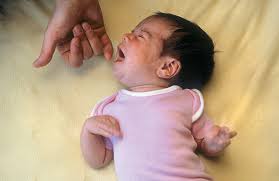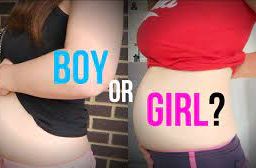
Baby Crying Signals – Understanding Your Baby’s Needs
Understanding Baby Crying Signals: Causes and Solutions for Parents

When babies need something, they often start crying. It’s their way of telling us they’re hungry, uncomfortable, or have other needs. In the picture below, you can see a baby crying and trying to find milk. This is a clear sign they’re hungry. Let’s learn more about what babies are trying to tell us with their cries.
- Hunger: Hunger is one of the most common reasons for a baby to cry. If the baby has been fed recently and is still crying, other factors may be at play.

-
- Cue: Rooting, putting hands to mouth, sucking on fists. Intense crying with a rhythmic pattern.
- Example: Your baby has been sleeping for a while, wakes up, and starts crying, showing signs of rooting, even though they were fed a few hours ago. After feeding, the crying stops.
- Diaper Change: A wet or soiled diaper can cause discomfort. Check the baby’s diaper and change it if necessary.
- Cue: Restless crying with some discomfort and fussiness.
- Example: Your baby is fed, but the crying persists. Upon checking, you find that the diaper is wet or soiled.
- Sleepiness: Babies may cry when they are tired or overstimulated. Creating a calm and quiet environment can help soothe a tired baby.
– Example:- Cue: Irritable crying, rubbing eyes, yawning and becoming fussy.
- Example: Your baby has been awake or active for a while but suddenly becomes fussy and displays signs of tiredness. Their crying is accompanied by yawning and eye rubbing.
- Discomfort or Pain: Babies may cry if they are uncomfortable due to tight clothing, a hair wrapped around a finger or toe, or any other physical discomfort.
- Cue: Crying that seems sharp or sudden, Sharp or sudden cries, may be accompanied by physical discomfort signs such as clenched fists and arching back.
- Example: Your baby is crying and seems uncomfortable; upon investigation, you find a hair wrapped around their finger. The baby cries, suggesting discomfort until a tight piece of clothing is adjusted.
- Need for Burping: If a baby has swallowed air during feeding, they may need to be burped to release the gas.
- Cue: Fussiness during or after feeding, pulling away from the bottle or breast.
- Example: Your baby has just finished feeding but seems uncomfortable, arching their back and showing signs of gas. Gently patting on the back helps release gas. Burping helps relieve the discomfort.
- Wanting to Be Held: Babies often seek comfort and security through physical contact. Holding, rocking, or gentle bouncing can help soothe a crying baby.
- Cue: Reaching out, crying that intensifies when put down and stops when picked up.
- Example: Your baby is crying while lying in the crib, but when you pick them up, they immediately calm down and seek closeness.
- Overstimulation: Too much noise, bright lights, or a busy environment can overwhelm a baby. Moving to a quieter space may help.
- Cue: Increasing fussiness, avoiding eye contact, turning head away. Crying intensifies in a busy or noisy environment.
- Example: You’re at a social gathering, and your baby, who was fine earlier, starts crying when the noise level increases. Their crying escalates as the stimulation continues.
- Loneliness or Boredom: Babies enjoy interaction and may cry when they feel lonely or bored. Talking, singing, or playing with the baby can be comforting.
- Cue: Fussiness and crying without an apparent cause; despite being fed and changed; seeking attention.
- Example: Your baby is fed, changed, and comfortable, but they still seem fussy. Engaging in play or conversation alleviates the crying. The baby is alone in the crib, and their crying stops when you engage with them or pick them up.
- Temperature: Check if the baby is too hot or too cold. Adjust their clothing or the room temperature accordingly.
- Cue: Crying due to being too hot or too cold. Red or flushed skin (too hot), shivering or cold to the touch (too cold).
- Example: Your baby is fussing and crying; checking their body temperature reveals they are sweaty, indicating overheating or too cold.
- Illness or Discomfort: If a baby continues to cry and you cannot identify a specific cause, they may be unwell. Check for signs of illness, such as a fever, and consult a healthcare professional if needed.
-
- Cue: Persistent crying, changes in behavior, signs of illness (fever, vomiting, lethargy, etc.).
- Example: Your baby’s crying is different from usual, they continue to cry despite addressing basic needs, and you notice that they symptoms of illness such as a fever or lethargy. Seeking medical advice is advisable in this situation.
- Teething Discomfort: Teething is the process of a baby’s teeth emerging through the gums. The discomfort is due to the pressure and inflammation associated with the teeth breaking through. Babies may try to alleviate the pain by chewing on objects, and swollen gums are a common sign.
- Cue: Excessive drooling, chewing on hands or objects, swollen gums.
- Example: The baby is crying, and you notice they are gnawing on their fingers while showing signs of swollen gums. This could indicate that the baby is teething, and the discomfort associated with new teeth emerging is causing distress.
- Sensory Overload:
- Cue: Irritability, covering ears, avoiding eye contact.
- Example: The baby is exposed to loud music or bright lights, leading to distress and crying.
- Dirty Environment:
- Cue: Crying in response to strong odors or environmental irritants.
- Example: The baby cries when exposed to a strong perfume or cleaning product.
Lack of Stimulation:
- Cue: Crying out of boredom, especially as the baby becomes more aware.
- Example: The baby is in a quiet room for an extended period and starts crying, seeking stimulation.
- Wants a Change of Scenery:
- Cue: Crying that persists in a particular environment.
- Example: The baby is crying in the nursery, but when taken to a different room, the crying stops.
Overtiredness: When a baby is overtired, they may find it challenging to calm down and settle for sleep. Rubbing their eyes and increased fussiness are signals that the baby is fatigued and may have missed their usual nap time.
- Cue: Difficulty settling down, rubbing eyes, yawning, becoming fussier.
- Example: Your baby has missed their nap and their crying is accompanied by increased irritability and difficulty they are now having trouble calming down and falling asleep. This suggests that the baby is overtired, and the lack of sufficient rest is affecting their mood and ability to settle.
Sensory Sensitivity: Some babies are more sensitive to sensory stimuli, such as loud noises or specific textures. Their heightened sensitivity can lead to easily being startled or expressing discomfort when exposed to certain sensory experiences.
- Cue: Startling easily, aversion to certain textures or sounds.
- Example: The baby cries when exposed to loud noises or when touched with a certain texture, indicating sensitivity.
- Gas or Colic: Gas or colic can cause discomfort in the baby’s digestive system. The pulling of legs toward the belly and clenching of fists are attempts to relieve abdominal pain associated with gas.
- Cue: Pulling legs toward the belly, clenching fists, crying in a high-pitched manner.
- Example: Your baby experiences bouts of intense crying accompanied by signs of discomfort in the abdominal area, such as pulling legs up, often in the evening, associated with gas or colic.
Allergies or Sensitivities: Allergic reactions or sensitivities to certain foods or environmental factors can cause ongoing discomfort. Symptoms may include persistent crying, skin reactions like rashes, and digestive issues.
- Cue: Persistent crying accompanied by skin rash, hives digestive issues or other signs of an allergic response.
- Example: Your baby cries after being introduced to a new food, and there are signs of an allergic reaction, such as a rash or digestive discomfort.
- Uncomfortable Clothing: If a baby is uncomfortable in their clothing, they may try to communicate this by tugging at it or displaying irritability. It could be due to tightness, scratchy fabric, or other factors.
-
- Cue: Tugging at clothing, irritability when dressed.
- Example: The baby seems distressed, and upon inspection, you discover that a clothing tag is bothering them.
22. Need for Change in Position: Babies may become restless or cry if they are uncomfortable in a particular position. Changing their position can provide relief and comfort.
-
- Cue: The baby is restless or crying after being in the same position (e.g., lying on their back) for an extended period and stops when the baby is repositioned. Fussiness when held in a particular position for too long.
- Example: The baby is crying, and when you change their position from lying down to sitting up, the crying diminishes.
23. Lack of Stimulation: Babies thrive on stimulation, and a lack of it can lead to boredom or disinterest. This may result in quietness or a subdued demeanor.
-
- Cue: Quietness, lack of interest in surroundings.
- Example: The baby is in a quiet room for an extended period, and their crying seems to result from a lack of stimulation.
24. Regression or Developmental Leap: During developmental leaps, babies may experience changes in behavior, including increased fussiness and altered sleep patterns. These periods are often associated with significant developmental milestones.
-
- Cue: Changes in sleep patterns, increased fussiness.
- Example: The baby’s behavior shifts, and they become more demanding or fussy during a developmental leap or regression.
25. Emotional Discomfort: Babies can experience emotional discomfort, seeking comfort and reassurance from caregivers during times of stress or unease. This may manifest as clinginess and changes in behavior.
-
- Cue: Clinginess, seeking comfort, changes in behavior.
- Example: The baby is more emotional than usual, seeking more comfort and reassurance from caregivers.
Disclaimer: This blog post is intended solely for informational purposes and does not constitute medical advice. Always consult with a qualified healthcare professional for personalized guidance regarding your specific health situation.
















